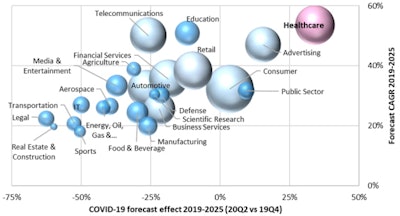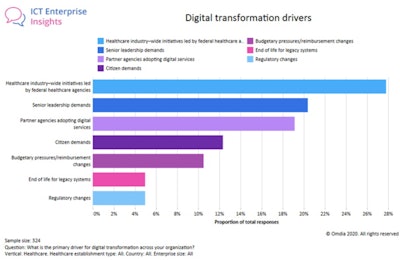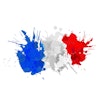
The COVID-19 pandemic had a substantial impact on radiology in 2020, and the RSNA annual meeting was no exception. While the virtual conference still showcased its usual lineup of important product launches, research findings, and technologies, COVID-19 was the main story.
The COVID-19 health crisis has stimulated a groundswell of innovation in the medical community, including advancements in artificial intelligence (AI), digital transformation, telemedicine, product launches, and new healthcare infrastructure. Such innovations were featured at the RSNA 2020 meeting and provide insight into the outlook of the healthcare industry in 2021.
The case for healthcare AI continues to grow
In recent years, AI has had an increasingly high profile at the RSNA meeting. This was certainly the case in 2020 as many new AI solutions were on display. One AI developer, for example, showcased the results of a study that found that its AI software improved radiologists' diagnostic accuracy and specificity by 25% and 34% respectively, as well as reduced the time required to read normal exams when interpreting mammograms.
AI software is pivotal in nations with a shortage of experienced radiologists and will drive growth for the mammography equipment market. Omdia forecasts that after a sharp decline in 2020, mammography equipment revenue will grow at a compound annual growth rate (CAGR) of over 7% from 2020 to 2024.
Also on display at RSNA 2020 was the latest iteration of AI solutions designed to detect symptoms of COVID-19 from CT and x-ray images -- two modalities that have been heavily relied upon during the pandemic. As a result of the increased demand caused by COVID-19, Omdia estimated that CT and general radiography x-ray equipment revenue grew by 5% and 14% respectively in 2020, while overall medical imaging revenue declined by 8%.

Collaboration between AI vendors, healthcare equipment manufacturers, and healthcare providers is set to drive further AI development and adoption in 2021 and beyond. At RSNA 2020, NVidia announced the launch of the Inception Alliance program, which will facilitate partnerships between medical imaging AI startups, GE Healthcare, and Nuance. The program aims to fast-track development of AI for healthcare and link software development with the medical imaging community.
To reach its full potential in the healthcare market, AI technology must overcome daunting barriers to adoption, including IT and workflow integration. At the annual meeting, GE Healthcare featured advancements to its Edison AI platform that help address these challenges.
COVID-19 is accelerating healthcare digital transformation
While COVID-19 intensified many existing healthcare challenges -- including personnel shortages -- it also acted as a catalyst to drive progress in delivering more effective healthcare to patients.
One of the key trends observed at RSNA 2020 was the rapid acceleration of digital transformation technologies in the healthcare industry. However, the transformation process represents several challenges that must be overcome:
- High cost and complexity of integrating new technologies
- Lack of compatibility with legacy platforms
- Data protection and cybersecurity
- Compliance with a dynamic regulatory environment
For its 2020 Information and Communications Technology (ICT) Enterprise Insights, Omdia surveyed more than 300 healthcare information technology (IT) professionals about digital transformation. These healthcare providers identified government initiatives, internal business demands, and partner agencies adopting digital services as the top three drivers for digital transformation.

At RSNA 2020, Philips Healthcare launched its Radiology Operations Command Center (ROCC), a digital platform that aims to serve as a centralized hub to improve communication and data exchange between radiologists, administrators, technologists, and IT personnel across multiple imaging sites. In 2021, Omdia forecasts the continued development of products in this space from multinational healthcare technology manufacturers as they aim to streamline healthcare workflows and address radiologists' challenges.
Telemedicine demonstrates industry-altering benefits
Telemedicine has become a vital technology in the world of healthcare, especially during the pandemic. Advancements in telemedicine technology have improved the access of patients to remote healthcare providers, helping to reduce the spread of COVID-19. With broader use of telemedicine, demand is expected to remain strong in 2021 and beyond.
Telemedicine can yield earlier detection and diagnosis, improved patient outcomes and satisfaction, and lower cost of care. These benefits are a product of the technology's ability to improve and streamline patients' access to quality healthcare by enabling examinations to be conducted from home or local facilities. In the case of medical imaging, radiologists can remotely guide medical staff at point-of-care imaging facilities during scan acquisition and then review scans remotely.
A number of telemedicine solutions and applications were on display at RSNA 2020. Konica Minolta introduced its Exa Gateway -- a teleradiology platform that connects remote radiologists with healthcare practices, utilizing facilities' existing PACS to minimize cost. Additionally, USARad announced a new patent for a decentralized method designed to enhance the telemedicine workflow by matching radiologists with healthcare facilities and AI vendors.
Solutions like these enhance the benefits of telemedicine and will help to cement the technology's place in the healthcare market even after the pandemic.
Product launches increase access to medical imaging
As in most years, RSNA 2020 featured the introduction of numerous medical imaging product lines. Many of these launches, such as multiple C-arm and point-of-care ultrasound systems, represent efforts to develop and deploy ambulatory care systems as part of an industry-wide theme of increasing patients' access to medical imaging.
Point-of-care medical imaging improves patient outcomes by increasing the likelihood of early detection and diagnosis and reduces patients' costs for care. Healthcare providers also benefit by increasing patient throughput and utilizing lower-cost systems for simpler cases, which frees up hospital space and systems for advanced cases.
In 2021, Omdia forecasts the continued development of bedside technology and ambulatory care systems aimed at easing the burden on hospitals that are struggling to provide critical care to patients with COVID-19.
Learning from the pandemic -- preparing for the future
Research presented at the RSNA 2020 conference displayed the tremendous amount that the medical community has learned about COVID-19, including studies on comorbidities and nonpulmonary complications and award-winning findings on the use of CT to detect the virus. Research and experience have enabled healthcare providers to improve approaches to diagnosing and treating COVID-19 patients, and manufacturers quickly played their part by providing resources and tools, many of which were on display at RSNA 2020. Solutions ranged from point-of-care medical imaging equipment to 3D-printed nasal swabs and predictive COVID-19 algorithms.
In 2021, the healthcare industry will look to settle into the "new normal" but will face sizeable headwinds, including heightened budget constraints following the overextension of resources during the pandemic. 2020 served as proof of the healthcare industry's immense capabilities for ingenuity through collaboration and innovation, which will continue to be in high demand in 2021.
Adam Davidson is a market research manager and Sharjeel Ahmad is a market research analyst with Omdia. Their Analyst Commentary: Top 2021 healthcare trends on display at RSNA 2020 was published in January 2021.
The comments and observations expressed are those of the authors and do not necessarily reflect the opinions of AuntMinnieEurope.com.


















